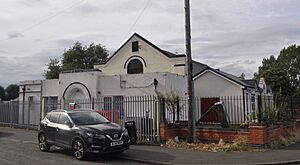St Cuthbert's Church, Winson Green facts for kids
Quick facts for kids St Cuthbert’s Church, Winson Green |
|
|---|---|

The former church hall in August 2024
|
|
| 52°29′17.4″N 1°56′18.2″W / 52.488167°N 1.938389°W | |
| Location | Birmingham |
| Country | England |
| Denomination | Church of England |
| History | |
| Dedication | St Cuthbert |
| Consecrated | 19 March 1872 |
| Architecture | |
| Architect(s) | Bateman and Corser |
| Construction cost | £5,000 |
| Closed | 1960 |
| Demolished | 1964 |
| Specifications | |
| Capacity | 720 people |
St Cuthbert's Church in Winson Green was once a special church in Birmingham. It belonged to the Church of England.
Contents
History of St Cuthbert's Church
How the Church Started
St Cuthbert's Church began as a small project in 1863. It was like a branch of All Saints' Church, Hockley. People worked hard to raise money for a proper church building. The church was designed by architects Bateman and Corser. It was officially opened and blessed on October 24, 1860.
Changes to the Parish
In 1904, a part of St Cuthbert's area became a new church community. This new community was for the Bishop Latimer Memorial Church, Winson Green.
The Church During Wartime
During the Second World War, a bomb hit St Cuthbert's Church. Even though it reopened, it did not stay open for long. The church closed its doors in 1960. Four years later, in 1964, the building was taken down.
What Remains Today
The church hall, which was part of the original church property, is still standing. Today, it is used as a community center for the Bengali people. The area that used to be St Cuthbert's parish was later joined with Christ Church, Summerfield.
The Church Organ
Details of the Organ
St Cuthbert's Church had a special musical instrument called an organ. This organ was put in by a company named Bishop, Starr & Richardson. You can find more technical details about this organ on the National Pipe Organ Register. This register keeps records of many organs across the country.

